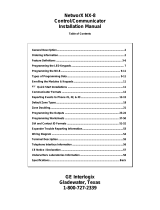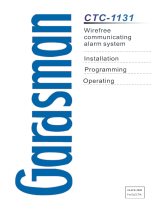
iii
Table of Contents
••••••••••••••••••••••••••••••••••••••••••••••••••
SECTION 1. Introduction............................................................................................................................1–1
Description........................................................................................................................................................1-1
Features.............................................................................................................................................................1-1
SECTION 2. Installing the Control...........................................................................................................2–1
Mounting the Cabinet ......................................................................................................................................2-1
Installing the Lock (if used).............................................................................................................................2-1
Mounting the Control's Circuit Board Alone in the Cabinet .........................................................................2-2
Mounting the Control and RF Receiver Circuit Boards Together.................................................................2-2
Standard Phone Line Connections..................................................................................................................2-3
SECTION 3. Installing Remote Keypads.................................................................................................3–1
Keypads That May Be Used.............................................................................................................................3-1
Wiring to the Keypads......................................................................................................................................3-1
Mounting the Keypads.....................................................................................................................................3-2
Supplementary Power for Additional Keypads ..............................................................................................3-2
Preliminary Checkout Procedure ....................................................................................................................3-3
SECTION 4. Basic Hardwired Zones 1–6.................................................................................................4–1
Installing the Hardwired Zones.......................................................................................................................4-1
Programming Hardwired Zones ......................................................................................................................4-2
SECTION 5. Wireless Expansion (5800 System) ....................................................................................5–1
About Wireless Expansion ...............................................................................................................................5-1
Installing the 5881/5882 Receiver ...................................................................................................................5-2
Installing the 5800TM Module ........................................................................................................................5-3
About Jam Detection and Reporting...............................................................................................................5-3
5800 Series Transmitters.................................................................................................................................5-3
Installing 5800 Series Transmitters................................................................................................................5-6
SECTION 6. Relay Output Devices...........................................................................................................6–1
Relay Device Basics..........................................................................................................................................6-1
4204 Relay Modules..........................................................................................................................................6-1
Programming Options......................................................................................................................................6-2
SECTION 7. 4285 and 4286 VIP Module...................................................................................................7–1
Installing the (Voice Interactive Phone) Module............................................................................................7-1
Programming the Control for Phone Access...................................................................................................7-4
Checking the Operation of the VIP Module....................................................................................................7-4
SECTION 8. External Sounders.................................................................................................................8–1
Compatible Sounders.......................................................................................................................................8–1
Sounder Connections and Power....................................................................................................................8–2
SECTION 9. Long-Range Radio.................................................................................................................9–1
About Long-Range Radio..................................................................................................................................9-1
Programming for Long-Range Radio...............................................................................................................9-1
Dynamic Signaling Feature.............................................................................................................................9-2
SECTION 10. Audio Alarm Verification (AAV) Unit.............................................................................10–1
About Audio Alarm Verification ....................................................................................................................10-1





















